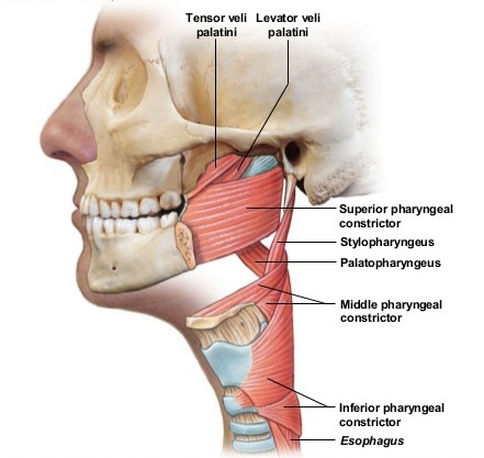This Rapid Vocal Results, blog addresses, the mechanics of how constrictor muscles work and how they can negatively impact on our vocal production. Very fitting for my first post for 2016, as it’s a big subject lots to tackle and its vital need to know info for every singer!
Regardless of your current level of singing ability, I am sure you will have experienced the frustration of going all out to sing a middle or high note with power and as you begin to produce the note or the scream you notice a feeling of tightness or squeezing in the back of the throat and correspondingly your voice simultaneously looses much of its dynamics, volume, tone etc and begins to sound small and choked off? If it has happened to you before on stage, or during a performance you will know exactly what I am describing and the negative effects it can have on your confidence as a performer.
That’s what happens when you use the big bulky muscles of the throat to support your vocal production. When you incorrectly sing this way , you’re going to automatically wake up the neighbours i.e. the “Constrictor muscles”.
Waking up the constrictor muscles is not the best idea when you sing, because it automatically reduces the internal diameter of our throat and significantly reduces the size of the resonating spaces (think, various mini amphitheatres or sound board areas) inside our throat whose job it is to naturally amplify and add rich over tones to our sounds when ever we vocalize.
Put simply; Incorrectly engaging the Constrictor muscles when we sing sets up a vicious circle where the outcomes are always going to be the same:
A. Decreased volume.
B. Severely impaired or muted tone. The poor singer sounds like they are being strangled.
C. The brain will recognise this restriction as a blockage in our throat and will automatically send the singer a message to push more air to remove the blockage and that unwanted excess air has to be held back by the vocal chords who will forget immediately about their singing duties and instead will tense up to withstand a barrage of hurricane like wind blasting at our vocal cords.
I am sure that you will agree, that any or all of the above aggravating conditions are less than ideal for melodic vocal production! When any one or all of these conditions is present in a singers voice, it’s a sure sign that the constrictors muscles are been incorrectly engaged in the job of vocal production.
If your reading this post and find yourself identifying with this unhealthy vocal pattern, don’t worry it can be resolved and remedied with some simple exercises to retrain these pesky constrictors muscles to remain switched off while we sing.
Before we go any further and suggest a remedy to the above vocal problem. Lets first understand what the constrictor muscles are and more importantly the vital role they play in our everyday lives to ensure our survival.
What are constrictor muscles? Where are they located? Why do we have them?
In simplified terms the constrictor muscles can be found inside our pharynx. Because these constrictor muscles are much larger than the micro muscle groups that are responsible for producing all aspects of our pitch, tone, volume and vocal effects ie grit rasp etc. Singers often make the mistake of feeling a strong connection to these big muscles when they sing.
The pharynx is, one of the major components of the anatomy that makes up our neck. Best described as a fibro-muscular tube forming part of both the digestive and respiratory systems and also plays a major role in our speech and singing production. The pharynx is divided into three major sections extending from the base of the skull to the cricoid cartilage of the oesophagus.
The nasopharynx, the oropharynx, and the hypopharynx (also known as the laryngopharynx) lie behind the cavities of the nasal passages, mouth, and larynx respectively. Various micro muscles support the function of the pharynx, and these muscles and nerves are continually sending tiny electrical impulses (communication signals) via both sensory and motor nerves connecting to our cervical spine.
Singers that have experienced problems with compression in the cervical vertebrae brought on through previous blunt force trauma episodes i.e. sports, car accidents, falls etc. Can find these blunt force traumas have negatively affected the healthy function of the nerve roots and the various blood vessels involved in regulating pharyngeal function this can have a big impact on the mechanics of a singers healthy vocal production. As both respiration and digestion are served by this area, serious problems can arise as a result of trauma to the neck, or degeneration and chronic dysfunction in the cervical spinal region. So if you’re a singer it’s really important to maintain your overall body health but especially back and neck function, and I definitely recommend that you include back and neck and laraynx stretches as part of your vocal warm up routine or back stage warm up pre gig.
The constrictor muscles and their location
There are six muscles which play a significant role in the function of the pharynx three of these muscles are circular and are constrictors, and three of these muscles are longitudinal (run lengthwise) in orientation and form an inner muscular ring. The three major muscles which constrict the pharynx are the superior pharyngeal constrictor (SC), the middle pharyngeal constrictor (MC), and the inferior pharyngeal constrictor (IC). The arrangement and position of these muscles has been compared to three stacked pots as they form a circular pattern one on top of the other.
Constrictor muscles are largely responsible for changing the shape and position of our throat to ensure food is correctly guided and moved to our oesophagus and later down to the stomach. In simple terms constrictor muscles ensure that, food ends up in our stomach as opposed to in our wind pipe! The problem is these same muscles can wreak havoc on our singing voice if they are incorrectly used to support our vocal production.
The SC (superior pharyngeal constrictor) connects the lingula of the mandible (lower jaw bone) to the hamulus (hook-like end) of the medial pterygoid plate. The MC originates from the hyoid bone’s greater horn. The IC (inferior pharyngeal constrictor) is connected to the thyroid gland and nearby cartilage and continues along with the oesophagus. All three constrictors join in the middle to form the seam known as the pharyngeal raphe. There are gaps formed by these three muscles to allow for certain structures to pass through.
When we sing, we need to know that if we incorrectly squeeze on the big bulky muscles in our throat in an effort to falsely support our vocal production, we will automatically switch on and engage the series of constrictor muscles and it will be virtually impossible to maintain our desired and coveted open throat position for singing.
Please note creating and maintaining an open throat when we sing is the absolute key and cornerstone foundation to allow the voice to smoothly connect up between our chest and head voice etc. A closed throat chokes off our available vocal tone as well as our range.
Pharynx muscles can affect nerve function
This is important, if we incorrectly squeeze and rely on the big bulky muscles in our throat to reach higher pitches or to artificially increase the volume or tone of our voice we run the risk of squeezing or compressing our laryngeal nerves.
The internal laryngeal branch of the superior laryngeal nerve passes through a gap between the MC and IC (inferior pharyngeal constrictor) along with the superior laryngeal artery from the superior thyroid artery. Finally, below the IC, the inferior laryngeal nerve and the inferior laryngeal artery are granted passage through the muscle. Excessive stresses, strains, create inflammation, and can lead to dysfunction of the muscles in this region. This can have significant ramifications for nerve function and circulation both to the pharynx itself but also the larynx and the thyroid. Conversely, inflammation or dysfunction in either of the latter two structures can greatly affect pharyngeal function and severely restrict the healthy closures of our vocal chords.
There is never a good reason to apply excessive force or tension to your vocal chords because you run the risk of not only damaging the vocal chords themselves but also the nerves that carry out the communication signals to the chords, this can result in a number of extensive vocal ailments, that i won’t go into detail on right now but one of the worst is a partial vocal paralysis of the chord its self. This can be brought on by a number of conditions, including a trapped laryngeal nerve etc.
Tom Keifer from the eighties Rock Band Cinderella experienced a similar vocal condition to the one I have out lined here its can have a debilitating effect on the singing especially in the upper register, it can require expert surgery to remedy and can take years to recover even then most ear nose and throat surgeons will agree that a singer that has experienced a partial paralysis of the vocal cord will never regain 100% of their original vocal cord function.
While there are multiple contributors that can cause partial paraylis of the vocal cords, including viral damage, etc. Singers need to understand that we can help maintain the health of our voice and lessen the risk of experiencing a partial cord paraylis by ensuring that we learn to sing in a healthy way that dose not place excessive pressure on our laranygeal nerves.
Worst case scenario. A Partial paralysis of the vocal cord means that the micro muscles that are responsible for producing vocal cord mass and vocal cord closure are weakened and one side of the vocal chords operates less efficiently than the other and due to the partial paralysis one side of the cord is unable to handle the same work load as before, leaving the voice unbalanced and prone to vocal wobbles and speed bumps cracks in the note etc.
Vocal exercise to re-train the constrictors muscles to switch off
If you think that your incorrectly engaging your constrictor muscles when you sing and its preventing you from reaching the full potential of your singing voice try this simple exercise to turn them off.
A. Starting on a low note four or five notes above your normal speaking voice vocalise on a lar sound, make sure you have a wide smile and 3/4 dropped jaw and yawn into the sound.
Then while maintaining all three actions simultaneously ie the smile and the yawn and the lar sound simply let your voice slide down again back to the original pitch of your speaking voice.
Observe as you descend in pitch were you able to maintain your lar sound with your 3/4 dropped jaw yawn? If you found that the back of your throat was closing as you slid down in pitch. Simply add more yawn and combine it with your lar sound until you can complete the exercise while maintaining your open throat position.
Then proceed to start on the next highest comfortable pitch and repeat the exercise over again. It takes time to retrain the constrictor muscles to remain switched off when we sing. Be patient it takes time to re train this type of unhealthy vocal habit.
For best results i recommend that you use a piano or guitar or similar musical instrument to accurately produce your starting pitch for each vocal slide. If you don’t have access to a music instrument like the above, there are lots of free software piano programmes online that you can use to help to make these exercises fun and enjoyable.
If you are having difficulty getting your constrictor muscles to behave and think you would benefit from one on coaching to reduce the time it takes to train the correct habits and vocal co-ordinations your welcome to contact me, via phone or email.
Better singing everyone.
Paule,
Conditioning and Performance Coach.











